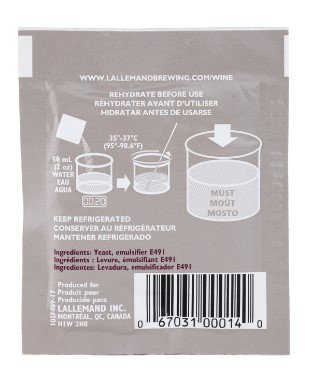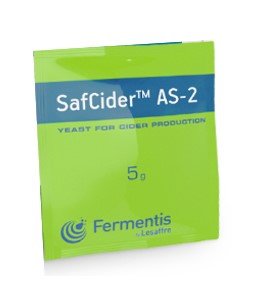LALVIN EC-1118™ Dry Yeast
The Original Prise de Mousse
The EC-1118™ strain was isolated, studied and selected from Champagne fermentations. Due to its competitive factor and ability to ferment equally well over a wide temperature range, the EC-1118 is one of the most widely used yeasts in the world.
The fermentation characteristics of the EC-1118™ — extremely low production of foam, volatile acid and hydrogen sulfide (H2S) — make this strain an excellent choice.
This strain ferments well over a very wide temperature range, from 10° to 30°C (50° to 86°F) and demonstrates high osmotic and alcohol tolerance. Good flocculation with compact lees and a relatively neutral flavor and aroma contribution are also properties of the EC-1118™.
The EC-1118™ strain is recommended for all types of wines, including sparkling, and late harvest wines and cider. It may also be used to restart stuck fermentations.
Alcohol Tolerance %: 18. Kit wines and sparkling wines.
Lalvin EC1118™ has been selected in a famous sparkling wine region for its excellent properties in producing sparkling base wine as well as “in-bottle” secondary fermentation.
It is very resistant to osmotic pressure. Lalvin EC1118™ is known for its robust and reliable fermentation kinetics. Its sensory contribution is considered neutral as it gives very little sensory contribution to the wine. It is used extensively in the world for the production of both white and red wines.
5grams
The Original Prise de Mousse
The EC-1118™ strain was isolated, studied and selected from Champagne fermentations. Due to its competitive factor and ability to ferment equally well over a wide temperature range, the EC-1118 is one of the most widely used yeasts in the world.
The fermentation characteristics of the EC-1118™ — extremely low production of foam, volatile acid and hydrogen sulfide (H2S) — make this strain an excellent choice.
This strain ferments well over a very wide temperature range, from 10° to 30°C (50° to 86°F) and demonstrates high osmotic and alcohol tolerance. Good flocculation with compact lees and a relatively neutral flavor and aroma contribution are also properties of the EC-1118™.
The EC-1118™ strain is recommended for all types of wines, including sparkling, and late harvest wines and cider. It may also be used to restart stuck fermentations.
Alcohol Tolerance %: 18. Kit wines and sparkling wines.
Lalvin EC1118™ has been selected in a famous sparkling wine region for its excellent properties in producing sparkling base wine as well as “in-bottle” secondary fermentation.
It is very resistant to osmotic pressure. Lalvin EC1118™ is known for its robust and reliable fermentation kinetics. Its sensory contribution is considered neutral as it gives very little sensory contribution to the wine. It is used extensively in the world for the production of both white and red wines.
5grams
The Original Prise de Mousse
The EC-1118™ strain was isolated, studied and selected from Champagne fermentations. Due to its competitive factor and ability to ferment equally well over a wide temperature range, the EC-1118 is one of the most widely used yeasts in the world.
The fermentation characteristics of the EC-1118™ — extremely low production of foam, volatile acid and hydrogen sulfide (H2S) — make this strain an excellent choice.
This strain ferments well over a very wide temperature range, from 10° to 30°C (50° to 86°F) and demonstrates high osmotic and alcohol tolerance. Good flocculation with compact lees and a relatively neutral flavor and aroma contribution are also properties of the EC-1118™.
The EC-1118™ strain is recommended for all types of wines, including sparkling, and late harvest wines and cider. It may also be used to restart stuck fermentations.
Alcohol Tolerance %: 18. Kit wines and sparkling wines.
Lalvin EC1118™ has been selected in a famous sparkling wine region for its excellent properties in producing sparkling base wine as well as “in-bottle” secondary fermentation.
It is very resistant to osmotic pressure. Lalvin EC1118™ is known for its robust and reliable fermentation kinetics. Its sensory contribution is considered neutral as it gives very little sensory contribution to the wine. It is used extensively in the world for the production of both white and red wines.
5grams



















